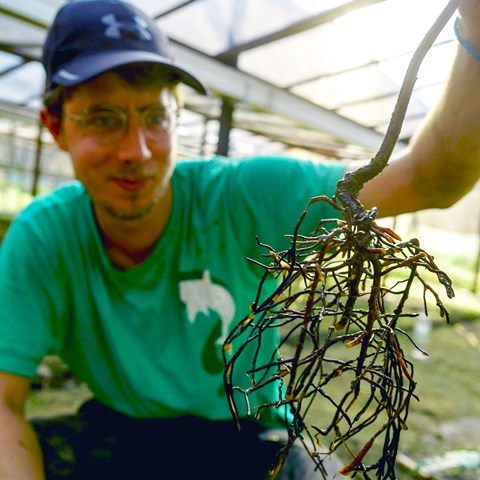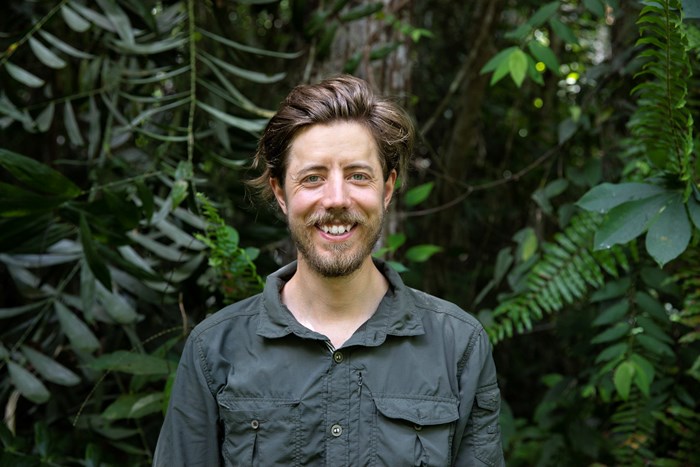Selecting the right tree species a possible key to sustainable forestry in the tropics

Rainforests on Borneo have experienced large scale losses because of both unsustainable forestry and the expansion of oil palm plantations. Meanwhile the resources from the tropical forests are needed in the transition toward a fossil free economy. In his Doctoral thesis, PhD-student Arvid Lindh at SLU shows how conscious tree selection can help restore the damaged forests, and still turn a profit.
In the Sabah region of the Malaysian part of Borneo, the Swedish University of Agricultural Sciences has been participating in a major research and restoration project for 25 years. This unique project has led to over five million new trees being planted, and has enabled extensive research on restoration in tropical forests.
Since 2018, Arvid Lindh, a PhD student at the Department of Forest Ecology and Management at SLU, has studied how planting different species of trees both generate profitability and promote biodiversity in the forest. In his thesis, he explains that there is significant untapped potential in the degraded and partially logged rainforests.
“These rainforests, which show signs of partial deforestation, are generally referred to as secondary forests. But this term carries a negative connotation and can often be misleading and oversimplified,” says Arvid Lindh.
The beetles’ unexpected favorite: Trees with smaller leaves
In 2008, over 20 different native tree species were randomly planted in rows in a partially degraded forest, and their growth has been carefully monitored ever since. By categorizing the tree species based on individual characteristics such as resistance to insects, nutrient concentration, and leaf pH levels, the researchers were able to link certain tree traits to the success of the replanting efforts. A surprising conclusion was that the fastest-growing trees were not ultimately the most profitable, as they had a significantly lower survival rate compared to some of the slower-growing ones (read more about this study here).
The researchers, along with colleagues from Sabah, also investigated which types of beetles these new trees attracted. Beetles are often used as an indicator group because of their many different functions within the ecosystem, and their presence is associated with higher overall biodiversity. More than 350 beetle species were observed and could, in turn, be linked to the characteristics of the trees they were found in. Most beetles, including wood- and leaf-eating species, generally preferred trees with soft leaves. Surprisingly, the size of the leaves also proved significant, with trees with small leaves being more favoured. Different characteristics, however, attracted predatory beetles and fungus-eating beetles.
Finally, the researchers examined how a future climate with fewer rain events and less overall precipitation would affect the decomposition of leaves from trees with different leaf traits. Mesh bags filled with leaves were placed alongside young tree seedlings under rain shelters and then watered by hand at set intervals. The results showed that both reduced total rainfall and longer intervals between rain events slowed down decomposition. The results showed that leaf traits that affect decomposition the most under current conditions were also the most important in these experiments.
The right combination offers the best of both worlds
The researchers concluded that no single tree species can provide all ecosystem services on its own. But with the right combination of trees, a restoration effort can have the best possible chances of achieving multiple beneficial outcomes. And Arvid Lindh has identified a promising pair after his experiments.
“Rubroshorea ovalis and Shorea leptoderma are two tree species that performed well in both the growth experiment and in attracting a high diversity of beetles. These two could serve as solid cornerstones when selecting species to include in restoration. They can then be complemented with species that have other characteristics and strengths.”
He hopes that the new research can guide the forestry industry in Borneo towards a more sustainable direction.
“The tropical forests will be very important as we transition to a more bio-based economy. They cover more land than the boreal forests and grow faster. If we can establish good and sustainable forestry practices there, it could provide great benefits,” says Arvid Lindh.
Link to the scientific article: https://publications.slu.se/?file=publ/show&id=130466
Read an in depth news article on one of the thesis' studies.
Read more about SLU:s research in Borneo through the Sow a Seed-project.
Arvid Lindh defends his doctoral thesis on the Swedish University of Agricultural Sciences in Umeå at 9 am on 6 September. Find more information, and a link to the full thesis here.
Download high resolution images
Images are free to use in publications related to this news article. Photographer credits are required.
Arvid Lindh in Borneo. Photo: Susanna Bergström/SLU.
Arvid Lindh holding a tree sapling of the species Bornean Ironwood, Eusideroxylon zwageri or Belian as it is locally named. Photo: Ulrik Ilstedt/SLU.
The primary study plot in the project. Indigenous trees were planted in rows in a forested area that was selectively deforested and subject to forest fires in the 1980’s. Photo: Arvid Lindh/SLU.
One of the tallest growing trees since the start of the replanting project in 2008. This tree is approximately 40 meters tall with a diameter of about 60 cm. Photo: Arvid Lindh/SLU.




